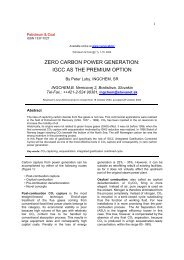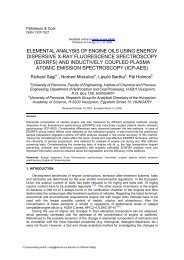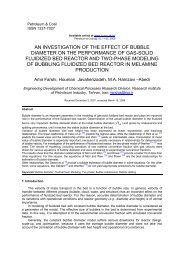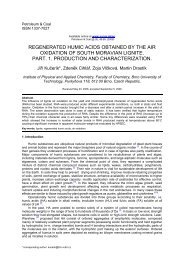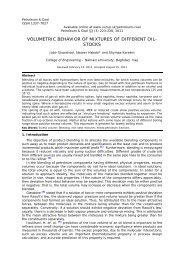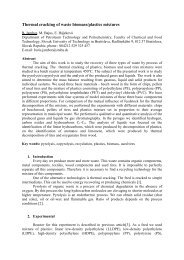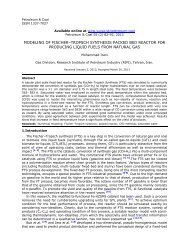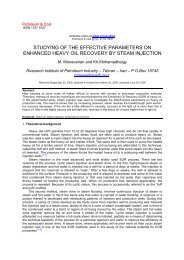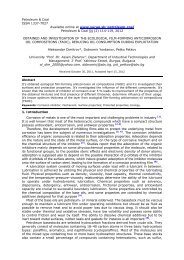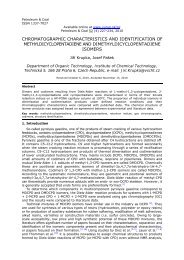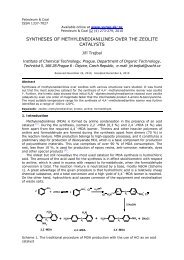permeability estimation and hydraulic zone pore structures
permeability estimation and hydraulic zone pore structures
permeability estimation and hydraulic zone pore structures
You also want an ePaper? Increase the reach of your titles
YUMPU automatically turns print PDFs into web optimized ePapers that Google loves.
Y. B. Adeboye, C. E. Ubani, K. K. Farayola/Petroleum & Coal 54(1) 52-58, 2012 53as defined by tortuosity; by the internal <strong>pore</strong> surface roughness <strong>and</strong> shape as defined by specificsurface area per unit <strong>pore</strong> volume; <strong>and</strong> by the mean <strong>hydraulic</strong> radius of <strong>pore</strong> throats in fluidconduits. The rock properties above are adequate for defining a <strong>permeability</strong> relationshipwithin a reservoir.A widely used equation linking porosity <strong>and</strong> <strong>permeability</strong> was proposed in 1927 by Kozenyin a model which represents fluid flow in capillary tubes. Kozeny derived his model equationby algebraically combining Darcy <strong>and</strong> Poiseuille’s equation to yieldk35(1 )S2 2pv(1)Carman [9] , developed a more closely representative reservoir conditions using the geometryof a spherical bead pack, altered the constants from five to two. A large deficiency with theseequations is the specific surface area <strong>and</strong> <strong>pore</strong> volume which have direct link with <strong>permeability</strong>in clean s<strong>and</strong>stones well sorted grains were not considered.Coates <strong>and</strong> Dumanoir [3] developed a <strong>permeability</strong> relationship to ensure zero <strong>permeability</strong>at zero porosity <strong>and</strong> at 100 % water saturation. However, Timur [2] developed equationwhich is widely used in porosity to <strong>permeability</strong> transform was used here to compare empirical<strong>permeability</strong> <strong>estimation</strong>s to those made with statistical methods.0.136( 100)k 2( )S wir4 0.4Empirical <strong>permeability</strong> relationships do not directly include <strong>pore</strong> throat size. This is a problembecause <strong>pore</strong> throats have more influence over <strong>permeability</strong> than other <strong>pore</strong> attributes. Withconsideration for <strong>pore</strong> throat size, Tiab [7] developed the following <strong>permeability</strong> relationship givenin equation 3 where H c (<strong>hydraulic</strong> character) is a variable.k H c3( 1)2Hydraulic character is a variable that includes the “lumped” effect of mean <strong>pore</strong> throat/<strong>hydraulic</strong> radius; <strong>pore</strong> surface area per volume (S 2 pv ); <strong>and</strong> tortuosity (T). This essentialvariable can be approximated by porosity - <strong>permeability</strong> relationships; or measured by PetrographicImage Analyses (PIA), capillary pressure data or surface adsorption measurements.In this study, reservoirs are subdivided into layers <strong>and</strong> described as computer models forpredicting reservoir performance. The major challenge was in the model development wasthe integration of the engineering flow model with the geological faces model. However, thisrevealed that reservoirs can either be layered with geological knowledge or mathematicallywith knowledge of <strong>hydraulic</strong> character. Each face was considered to have unique <strong>hydraulic</strong>character with similar log response <strong>and</strong> fluid flow characteristics.Equation (3) was then modified algebraically to yield a mathematical explanation for amethodology to use porosity <strong>and</strong> <strong>permeability</strong> measurements to group reservoirs into <strong>hydraulic</strong><strong>zone</strong>s. Both sides of Eq. (3) are divided by porosity to yield Eq. (4).k2( 1) (4)2H cThe square root of each side of the equation 4 was then taken to yield Eq. (5).It should be noted that the square root of k/ϕ is Leverett’s mean <strong>hydraulic</strong> radius <strong>and</strong> isan approximation of the mean <strong>pore</strong> throat size in the core plug on which <strong>permeability</strong> wasmeasured.(2)(3)k10.5( 1)Hc(5)



